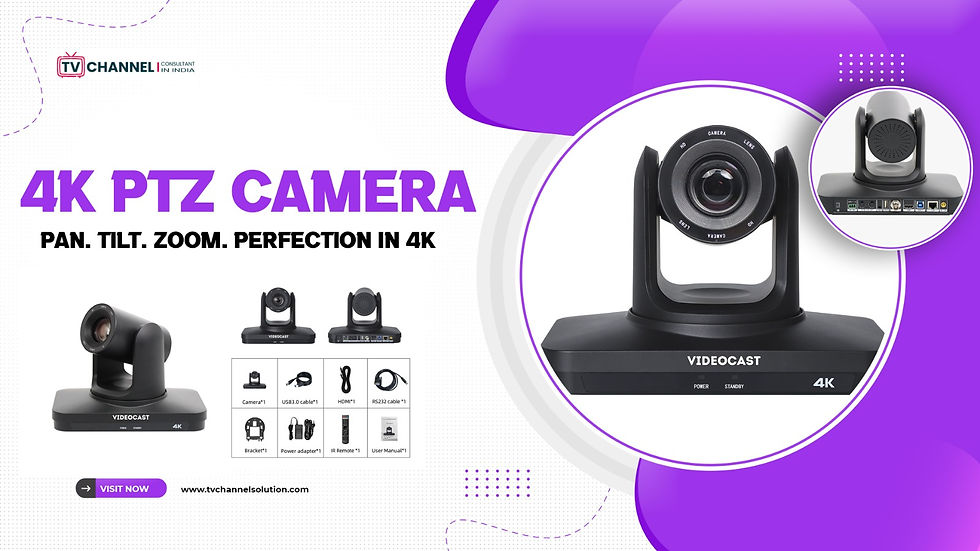Mastering Wireless Video Transmitter for Seamless Streaming
- Tv channel solution

- 1 day ago
- 4 min read
In modern film making and live production, speed and mobility matter. Whether it's a film set, a corporate live event, or a multi-camera outdoor shoot, cables can slow you down—literally. Wireless video transmitter has become the backbone of agile, cable-free production workflows, enabling real-time monitoring, switching and streaming without latency or connection drop-outs.

1. Importance of Wireless Video Transmitter in Modern Film making
Gone are the days when directors, cinematographers, and camera operators were tied to a mess of cables. Wireless video transmitter systems allow production teams to:
Move freely without cable limitations
View real-time footage from any camera on multiple monitors
Reduce setup time during shoots
Stream footage directly to switchers, encoders, or cloud platforms
In dynamic shoots—weddings, sports, concerts, live interviews—mobility equals creativity. Wireless systems empower videographers to capture spontaneous moments while maintaining professional-grade output quality.
2. Key Techniques for Effective Wireless Video Transmitter
To achieve uninterrupted streaming, professionals rely on a few core techniques:
Line-of-sight placement — Keep the transmitter path clear of physical obstructions.
Use dual antennas — Enhances signal strength and reduces packet drops.
Prioritize proper channel selection — Avoid channels crowded by Wi-Fi routers.
Maintain optimal distance — Transmitters have a maximum range; pushing limits reduces reliability.
Pro tip: Industrial-grade transmitters use frequency hopping and dynamic bandwidth adjustment to avoid interference.
3. Essential Gear for Seamless Streaming
The perfect wireless setup typically includes:
Pairing wireless transmitters with AI PTZ camera eliminates the need for manual tracking and enhances production workflows especially in hybrid events and live streaming.
4. Comparing Different Wireless Video Transmitter
For professional use, RF and SDI-based transmitters are the gold standard.\
5. Factors to Consider When Choosing Wireless Video Equipment
Before making a purchase, consider:
Transmitter distance (indoor vs outdoor range)
Latency (critical for live events and switching)
Video quality (1080p, 4K, HDR)
Battery life & portability
Compatibility with SDI/HDMI cameras
If you plan multi-camera live streaming, look for transmitters supporting multiple receiver outputs.
6. Troubleshooting Common Wireless Video Transmitter Issues
Most issues come from interference—changing the channel or clearing obstacles solves 80% of problems.
7. Best Practices for Setting Up Wireless Video Systems
Mount antennas vertically for maximum gain
Avoid placing transmitters near metal structures
Keep Wi-Fi routers away from RF equipment
Label each transmitter/receiver pair on multi-cam setups
For multi-camera workflows, use a dedicated wireless network to avoid traffic from other devices.
8. Future Trends in Wireless Video Technology
The future is wireless and smart.
Coming trends include:
AI-assisted auto-tracking & auto focus PTZ camera
5G cloud-based live streaming
Zero-latency wireless over IP
Multi-device remote monitoring on mobile/tablet
Soon, you’ll be able to stream a multi-camera event with just a backpack transmitter and a 5G connection.
Conclusion: The Future Is Wireless
Wireless video transmitter is transforming how productions are shot and streamed. Whether you're a filmmaker capturing cinematic shots or a production house managing hybrid events, wireless systems deliver flexibility, speed and creative freedom.
FAQ – Wireless Video Transmission & Streaming Gear
1. What is wireless video transmission?
Wireless video transmission allows video signals to be sent from a camera to a monitor or switcher without cables using a wireless video transmitter and receiver.
2. Can I use a wireless transmitter for live streaming?
Yes, wireless transmitters send video to switchers or encoders, making multi-camera live streaming easier and cable-free.
3. Can wireless transmitters work with PTZ or AI auto-tracking cameras?
Yes, wireless transmitters are compatible with PTZ and AI cameras for real-time monitoring and remote control.
4. Do wireless video transmitters support 4K video?
Many professional transmitters support both 1080p and 4K video with low latency.
5. Why does my wireless video feed drop or lag?
Signal drop usually happens due to interference or obstacles—try changing channels or improving line-of-sight.
6. Can one transmitter send video to multiple receivers?
Yes, many systems allow 1 transmitter to send video to 2–4 receivers simultaneously.
7. Is wireless video transmission secure for corporate events?
Professional wireless transmitters use encrypted transmission, making them secure for confidential meetings and streaming.
8. What equipment is required for wireless streaming?
You need a wireless video transmitter, receiver, PTZ or camera setup, and a streaming encoder/switcher.
Contact Us:
Email: info@skywirebroadcast.com
Phone: +91-9810321836, 7042004116
Website: https://www.tvchannelsolution.com/
_edited.png)








Comments